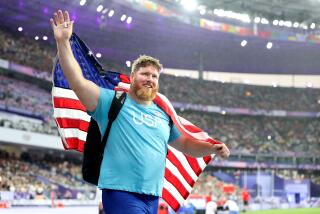NCAA TRACK AND FIELD : Kiss Sets Sights on Hammer Mark
- Share via
It was the new kid on the block arriving at the sandlot with a bat, asking, “Can I play?” and promptly breaking every window in the house across the street.
On the day before the 1993 NCAA hammer throw in New Orleans, Texas El Paso’s throwers agreed to work out with a much talked about but little seen freshman from USC, Balazs Kiss. “There were three of them throwing over 230 and all three had started the year with better marks than Balazs,” USC throw coach Dan Lange recalled. “We heard at the beginning of the year, ‘They’re going to go 1-2-3.’ ”
The Miners’ throwers watched Kiss start at 220 feet, then throw 228, then 232, then 236.
UTEP’s Mike Laaksonen had won the 1992 title at 233-11.
Warming to his task, Kiss went 239, 245, 252. End of practice session.
“They went from throwing 230 to hitting the cage and flying around,” Lange said. “After that, the meet was for second.”
Letting Kiss rattle the competition was easy and, well, kind of fun. Keeping Kiss from rattling himself was a different matter.
At the Pacific 10 meet a week before, the pressure of his first big competition had gotten to Kiss and he had not slept the night before the final. For all his physical gifts, he had arrived at USC short on high-pressure experience and shorter on temper.
In New Orleans, when Lange went to awaken Kiss the next morning, the door took all of two seconds to open.
Standing in his uniform, Kiss said: “I slept eight hours. The meet’s over.”
And it was. Kiss threw 246-10 to Laaksonen’s 233-7.
“Bo” to his teammates, the Balazs Kiss that dominated the 1993 NCAA meet was the world-class physical Kiss. The ersion that Lange and Kiss hope to unveil today in the NCAA hammer throw finals at Boise, Ida., will be one with a reworked psychological game.
“Balazs came in with a goal he thought was high, 75 meters (246 feet),” Lange said. “He surpassed that in the third meet. When you surpass your goal, it takes an adjustment period.” Said Kiss: “Its kind of like a barrier between a low 70-meter thrower and a high 70-meter thrower. It’s a big deal. If you’re a low 70-meter thrower, you’re just a prospect, just a promise.
“If you throw a 75, you can go to the Olympics and World Championships.”
Said Lange: “He should be thinking 80.” So, Lange introduced Kiss to a new set of training principles.
“I’m a Southern Californian, he’s from Hungary. We’re from a world apart,” Lange said. “The hammer is a rhythmic sport. You have to feel the weight and actually ride it, letting it do the work, rather than try and fight it out with your strength. You have to be strong and not use your strength.”
Lange’s approach didn’t appeal to Kiss. It was like telling Babe Ruth to bunt.
In April’s Mt. San Antonio College Invitational, Kiss bucked back. Frustrated at a lack of progress toward the NCAA record of 257 feet, he took the matter-over-mind approach and threw 248 feet, a crushing disappointment.
Then, Kiss started listening.
“He’s a totally different thrower now because he’s a totally different athlete,” Lange said. “He’s much more confident.”
More to Read
Go beyond the scoreboard
Get the latest on L.A.'s teams in the daily Sports Report newsletter.
You may occasionally receive promotional content from the Los Angeles Times.










